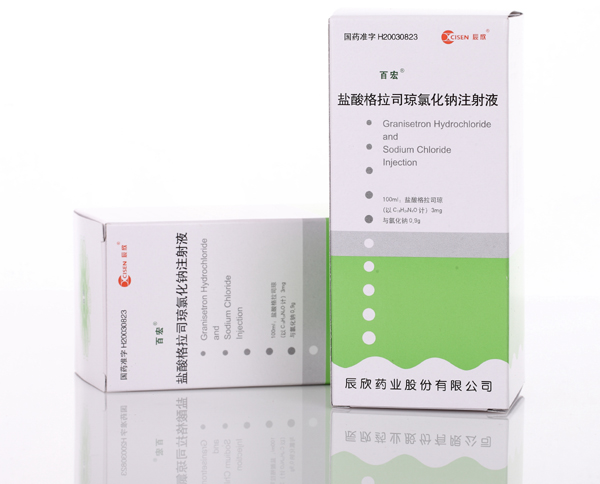Description: Granisetron Hydrochloride and Sodium Chloride Injection is the prevention of nausea and/or vomiting associated with initial and repeat courses of emetogenic cancer therapy, including high-dose cisplatin.The prevention and treatment of postoperative nausea and vomiting. Granisetron hydrochloride is a white to off-white solid that is readily soluble in water and normal saline at 20°C. Granisetron Hydrochloride and Sodium Chloride Injection is an antinauseant and antiemetic agent. Granisetron Hydrochloride and Sodium Chloride Injection is a clear, colorless, sterile, nonpyrogenic, aqueous solution for intravenous administration. Chemically it is endo-N-(9-methyl-9-azabicyclo[3.3.1]non-3-yl)-1-methyl-1H-indazole-3-carboxamide hydrochloride with a molecular weight of 348.9 (312.4 free base).
Pharmacological effects: Granisetron is a selective 5-hydroxytryptamine3 (5-HT3) receptor antagonist with little or no affinity for other serotonin receptors, including 5-HT1; 5-HT1A; 5-HT1B/C; 5-HT2; for alpha1-, alpha2- or beta-adrenoreceptors; for dopamine-D2; or for histamine-H1; benzodiazepine; picrotoxin or opioid receptors.Serotonin receptors of the 5-HT3 type are located peripherally on vagal nerve terminals and centrally in the chemoreceptor trigger zone of the area postrema. During chemotherapy-induced vomiting, mucosal enterochromaffin cells release serotonin, which stimulates 5-HT3 receptors. This evokes vagal afferent discharge and may induce vomiting.
Pharmacokinetics: Plasma protein binding is approximately 65% and granisetron distributes freely between plasma and red blood cells.Granisetron metabolism involves N-demethylation and aromatic ring oxidation followed by conjugation. In vitro liver microsomal studies show that granisetron's major route of metabolism is inhibited by ketoconazole, suggestive of metabolism mediated by the cytochrome P-450 3A subfamily. Animal studies suggest that some of the metabolites may also have 5-HT3 receptor antagonist activity.Clearance is predominantly by hepatic metabolism. In normal volunteers, approximately 12% of the administered dose is eliminated unchanged in the urine in 48 hours. The remainder of the dose is excreted as metabolites, 49% in the urine, and 34% in the feces.
Indications: The prevention of nausea and/or vomiting associated with initial and repeat courses of emetogenic cancer therapy, including high-dose cisplatin. The prevention and treatment of postoperative nausea and vomiting.
Precautions: The use of Granisetron Hydrochloride and Sodium Chloride Injection in patients following abdominal surgery or in patients with chemotherapy-induced nausea and vomiting may mask a progressive ileus and/or gastric distention. Granisetron does not induce or inhibit the cytochrome P-450 drug-metabolizing enzyme system in vitro. There have been no definitive drug-drug interaction studies to examine pharmacokinetic or pharmacodynamic interaction with other drugs; however, in humans, KYTRIL Injection has been safely administered with drugs representing benzodiazepines, neuroleptics and anti-ulcer medications commonly prescribed with antiemetic treatments. KYTRIL Injection also does not appear to interact with emetogenic cancer chemotherapies. Because granisetron is metabolized by hepatic cytochrome P-450 drug-metabolizing enzymes, inducers or inhibitors of these enzymes may change the clearance and, hence, the half-life of granisetron. No specific interaction studies have been conducted in anesthetized patients. In addition, the activity of the cytochrome P-450 subfamily 3A4 (involved in the metabolism of some of the main narcotic analgesic agents) is not modified by Granisetron Hydrochloride and Sodium Chloride Injection in vitro.
Adverse reaction: Chemotherapy-Induced Nausea and Vomiting, Headache, Asthenia, Somnolence, Constipation, Hypertension; hypotension, arrhythmias such as sinus bradycardia, atrial fibrillation, varying degrees of A-V block, ventricular ectopy including non-sustained tachycardia , and ECG abnormalities have been observed rarely. Agitation, anxiety, CNS stimulation, insomnia. Rare cases of hypersensitivity reactions, sometimes severe (eg, anaphylaxis, shortness of breath, hypotension, urticaria) have been reported. Fever , taste disorder , skin rashes.

